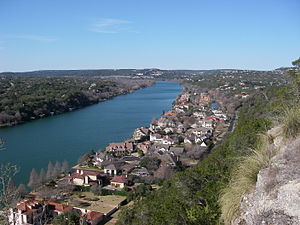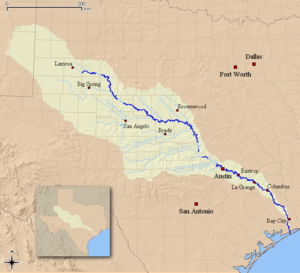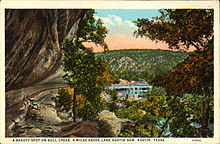- Colorado River (Texas)
-
Colorado River Texas Country  United States
United StatesState  Texas
TexasSource - location Dawson County - elevation 3,280 ft (1,000 m) [1] - coordinates 32°40′47″N 101°43′51″W / 32.67972°N 101.73083°W [2] Mouth Matagorda Bay - location Gulf of Mexico, at Matagorda County, Texas - elevation 0 ft (0 m) [1] - coordinates 28°35′41″N 95°58′59″W / 28.59472°N 95.98306°W [2] Length 862 mi (1,387 km) Basin 39,900 sq mi (103,341 km2) [3] Discharge for Bay City - average 2,609 cu ft/s (74 m3/s) - max 84,100 cu ft/s (2,381 m3/s) - min 0 cu ft/s (0 m3/s) The Colorado River is a river that runs through the U.S. state of Texas; it should not be confused with the much longer Colorado River which flows from Colorado into the Gulf of California.
The Colorado River is the 18th longest river in the United States[4] and the longest river with both its source and mouth within Texas;[3] its drainage basin and some of its usually dry tributaries extend into New Mexico. The 862-mile (1,387 km) long river[4] flows generally southeast from Dawson County through Marble Falls, Austin, Bastrop, Smithville, La Grange, Columbus, Wharton, and Bay City before emptying into the Gulf of Mexico at Matagorda Bay.[3]
Contents
Course
 Oblique air photo of the Colorado River where it crosses from Colorado County into Wharton County near Nada.
Oblique air photo of the Colorado River where it crosses from Colorado County into Wharton County near Nada.
The Colorado River originates south of Lubbock, on the Llano Estacado, near Lamesa. It flows generally southeast, out of the Llano Estacado and through the Texas Hill Country, through several reservoirs including Lake J.B. Thomas, E.V. Spence Reservoir, and Lake O.H. Ivie. The river flows through several more reservoirs before reaching Austin, including Lake Buchanan, Inks Lake, Lake Lyndon B. Johnson, commonly referred to as Lake LBJ, and Lake Travis. The Llano River joins the Colorado at Lake LBJ, near Kingsland. The Pedernales River joins the Colorado at Lake Travis near Briarcliff. After passing through Austin, the Colorado River continues flowing southeast until emptying into Matagorda Bay on the Gulf of Mexico, near Matagorda.
History
The Colorado River, which means "colored red",[5] was frequently confused by Spanish explorers with the Brazos River to the north.[3] It is this confusion as well as an alleged mapping error that is believed to have led to its misnaming.[citation needed]
The upper Colorado River was controlled by Comanches from the early 18th century to the late 19th century. In 1757, Spanish Texas attempted to establish an outlying mission on the San Saba River, near its confluence with the Colorado River. Nearly defenseless and viewed by the Comanche as a territorial invasion, the mission was sacked in 1758 by about 2,000 Comanches and their allies. The Comanche were not effectively challenged on the upper Colorado River for nearly a century.[6]
River modifications
The river is an important source of water for farming, cities, and electrical power production. Major man-made reservoirs on the river include Lake Buchanan, Inks Lake, Lake LBJ, Lake Marble Falls, Lake Travis, Lake Austin, and Lady Bird Lake in Austin. Collectively, these lakes are known as the Highland Lakes. In addition to power plants operating on each of the major lakes, waters of the Colorado are used for cooling the South Texas Nuclear Project, near Bay City. The Colorado River Municipal Water District owns and operates three reservoirs upstream of the Highland Lakes, Lake J. B. Thomas near Snyder, E. V. Spence Reservoir near Robert Lee, and O. H. Ivie Reservoir near Ballinger.
Flood control and use of the Colorado River is managed by two agencies established by the Texas Legislature, the Upper Colorado River Authority, and the Lower Colorado River Authority. There are 11 major reservoirs along the Colorado River.[7]
The Colorado River also has made many geographic landmarks such as Deep Eddy Pool in Austin, Texas.
-
Colorado River 5 miles (8 km) from its source along the Caprock Escarpment, border of Dawson and Borden County, Texas.
-
Colorado River under the Regency Suspension Bridge on the border of Mills and San Saba counties.
-
Scenic view of Colorado River meandering under a bridge overpass under Texas State Highway 60 in Wharton.
-
Pennybacker Bridge crossing the Lake Austin portion of the Colorado River.
See also
- List of crossings of the Colorado River
- Colorado Bend State Park
- Balcones Canyonlands National Wildlife Refuge
- Texas Hill Country
- Llano River
- Barton Creek
- Guadalupe River
- Pedernales River
- Brazos River
- Matagorda Bay
- List of longest rivers of the United States (by main stem)
Notes
- ^ a b Google Earth elevation for GNIS coordinates.
- ^ a b U.S. Geological Survey Geographic Names Information System: Colorado River
- ^ a b c d Clay, Comer; Kleiner, Diana J. (1999-02-15). "Colorado River". The Handbook of Texas Online. The General Libraries at the University of Texas at Austin and the Texas State Historical Association. http://www.tshaonline.org/handbook/online/articles/CC/rnc10.html. Retrieved 2006-07-22.
- ^ a b Kammerer, J.C. (1987). Largest Rivers in the United States. United States Geological Survey. http://pubs.usgs.gov/of/1987/ofr87-242/. Retrieved 2006-07-15.
- ^ http://www.wordreference.com/es/en/translation.asp?spen=Colorado
- ^ Hämäläinen, Pekka (2008). The Comanche Empire. Yale University Press. pp. 58–60. ISBN 978-0-300-12654-9. Online at Google Books
- ^ "River Basin Map of Texas" (JPEG). Bureau of Economic Geology, University of Texas at Austin. 1996. http://www.lib.utexas.edu/geo/pics/rivers.jpg. Retrieved 2006-07-15.
External links
Categories:- Rivers of Texas
- Geography of Dawson County, Texas
- Geography of Matagorda County, Texas
- Geography of Borden County, Texas
- Geography of Scurry County, Texas
- Geography of Mitchell County, Texas
- Geography of Coke County, Texas
- Geography of Runnels County, Texas
- Geography of Coleman County, Texas
- Geography of Concho County, Texas
- Geography of McCulloch County, Texas
- Geography of Brown County, Texas
- Geography of San Saba County, Texas
- Geography of Mills County, Texas
- Geography of Lampasas County, Texas
- Geography of Burnet County, Texas
- Geography of Travis County, Texas
- Geography of Bastrop County, Texas
- Geography of Fayette County, Texas
- Geography of Colorado County, Texas
- Geography of Wharton County, Texas
-
Wikimedia Foundation. 2010.







